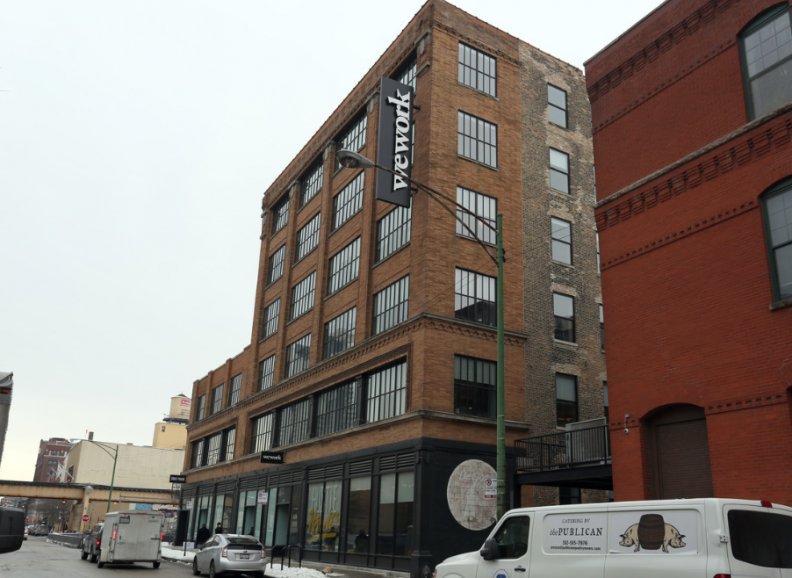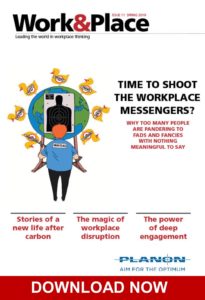The co-working provider’s top real estate exec shares his vision for growth and tells why he wants to put multiple locations close to each other.
A WeWork location in the Fulton Market District.
WeWork is the largest co-working provider in Chicago, with eight locations and 575,000 square feet either up and running or in the works. And the New York-based company has eyes for a lot more, Chief Real Estate Development Officer Granit Gjonbalaj said last week at a BMO Harris Bank real estate conference in Chicago. It’s part of a larger movement that is disrupting the world of traditional landlord-tenant leases. Gjonbalaj spoke to Crain’s about the company’s future here.
Q: What are your growth plans for Chicago?
We are interested in an iconic building in Chicago. I can’t tell you specifically which one it is, but it will make some great news here. We’re bullish on the market and we’re now working to figure out how we create relationships with landlords so that we can share some of the upside we’re enjoying. We now have dedicated real estate, design and construction teams in Chicago, and we have a great general manager for the market. We’re going to continue to grow here.
You’ve got clusters of locations in River North and the Loop. What other Chicago locations will you target?
We’re driven by demand. As we continue to connect to enterprise companies, they are indicating where is the next location to grow. We have found as a company that the more locations we open in a neighborhood, the better they do. So I think you’re going to continue to see WeWork locations around areas where we’ve already opened.
Why is it effective to open multiple locations close to each other?
You’re creating that energy, you’re activating the neighborhood, you’re activating the building so more people are attracted. That energy is what’s creating this ecosystem where the more buildings we open in those locations, the better we do. Everyone has different needs—you may want to do an off-site meeting for your team in a different area, building or environment. That’s why we enjoy a lot of success when we have a lot of locations in an area.
How are you addressing landlords who fear that co-working providers are risky tenants because many co-working users don’t have long-term commitments?
There’s a whole movement happening and you can’t sit on the sidelines and deny it. You have some landlords trying to figure out how to do flexible space themselves, and the more players we have in this category, the more it will be validated. Every landlord has to realize that this is the way people want to work. People don’t want to go to an office with a long hallway and mahogany doors for suites. Tenants from those suites don’t say hello to one another. People want to have conversations and they want to be connected. Now the conversations I’m having with landlords are about how we partner with them.
Co-working skeptics predict providers will struggle to retain tenants in a downturn. How big is that concern for the company?
Financially, we’re in a great position to weather any kind of softening of the economy. Nobody wants a downturn, but I don’t think we would suffer from it. There will be some companies that will not succeed, but the majority of companies are going to continue to do business. Some very large companies may want to downsize and go into a WeWork platform instead of being in a traditional office. When the economy softens, those decisions are probably a lot easier to make. Members are not going to just pack up and go. Some may shrink or grow, but with our financial backing, we’re in a very good position.
One of your executives recently projected that enterprise companies (those with at least 1,000 employees) will account for half of WeWork’s business by the end of 2019, up from about 30 percent today. How will that shape the size and types of real estate you pursue?
We’re now at the point where we’re reacting to the demand we have. HQ By WeWork is a product line we just launched in New York: We take full floors from 5,000 to 15,000 square feet, and when a client goes there, they really don’t see the WeWork brand as much as in other WeWork locations, but the design of the physical space and the tech infrastructure is all powered by WeWork. You might see a location where we’re taking 500,000 square feet and half of it may be enterprise companies. On the enterprise side, we have more than 1,700 companies and we’re learning so much from them, day in and day out.
There are a lot of different co-working providers emerging. Will we see WeWork grow here through acquisition?
At the end of 2017 we had 60 real estate professionals. Today we have 160. Between architects, designers, construction managers, project managers and that real estate team—globally, it is 1,300 people. Just in September we have opened 41 locations globally. We have the ability to react to demand and if we want to grow in a specific market, we can grow as much as we want. There’s going to be a downturn—the market is going to soften at some point down the road—and there may be some consolidations along the way, but our priority is really focusing on our team and making sure we’re continuing to grow the way we have.
Read Full Article from wework – Google News https://ift.tt/2NGe7Mx




